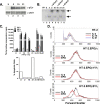Differential regulation of the IL-17 receptor by gammac cytokines: inhibitory signaling by the phosphatidylinositol 3-kinase pathway
- PMID: 18348982
- PMCID: PMC2376247
- DOI: 10.1074/jbc.M801357200
Differential regulation of the IL-17 receptor by gammac cytokines: inhibitory signaling by the phosphatidylinositol 3-kinase pathway
Abstract
The gammac-family cytokine IL-2 activates signaling events that contribute to cell survival and proliferation, the best-studied of which are the STAT-5 and phosphatidylinositol 3-kinase (PI3K) pathways. The starting point of this study was to define genes regulated by the IL-2R-mediated PI3K pathway in T cells. Accordingly, we used an erythropoietin (EPO) receptor chimeric receptor system in which IL-2-dependent HT-2 T cells expressed a mutant EPO-IL-2Rbeta construct where Tyr-338 is mutated to Phe. Cells expressing this mutant IL-2Rbeta chain fail to induce phosphorylation of PI3K-p85alpha/beta or activate Akt, but mediate normal IL-2-dependent proliferation and activation of JAK1 and STAT-5A/B. Microarray analyses revealed differential regulation of numerous genes compared with cells expressing a wild-type IL-2Rbeta, including up-regulation of the IL-17 receptor subunit IL-17RA. Blockade of the PI3K pathway but not p70S6K led to up-regulation of IL-17RA, and constitutive Akt activation was associated with suppressed IL-17RA expression. Moreover, similar to the mutant EPO-IL-2Rbeta chimera, IL-15 and IL-21 induced IL-17RA preferentially compared with IL-2, and IL-2 but not IL-15 or IL-21 mediated prolonged activation of the PI3K p85 regulatory subunit. Thus, there are intrinsic signaling differences between IL-2 and IL-15 that can be attributed to differences in activation of the PI3K pathway.
Figures







Similar articles
-
Late expression of granulysin by microbicidal CD4+ T cells requires PI3K- and STAT5-dependent expression of IL-2Rbeta that is defective in HIV-infected patients.J Immunol. 2008 Jun 1;180(11):7221-9. doi: 10.4049/jimmunol.180.11.7221. J Immunol. 2008. PMID: 18490721 Free PMC article.
-
Anti-apoptotic signaling by the interleukin-2 receptor reveals a function for cytoplasmic tyrosine residues within the common gamma (gamma c) receptor subunit.J Biol Chem. 2003 Mar 21;278(12):10239-49. doi: 10.1074/jbc.M209471200. Epub 2003 Jan 12. J Biol Chem. 2003. PMID: 12525482
-
Interleukin-2 (IL-2)-mediated induction of the IL-2 receptor alpha chain gene. Critical role of two functionally redundant tyrosine residues in the IL-2 receptor beta chain cytoplasmic domain and suggestion that these residues mediate more than Stat5 activation.J Biol Chem. 1997 Mar 28;272(13):8704-9. doi: 10.1074/jbc.272.13.8704. J Biol Chem. 1997. PMID: 9079703
-
IL-7: Comprehensive review.Cytokine. 2022 Dec;160:156049. doi: 10.1016/j.cyto.2022.156049. Epub 2022 Oct 3. Cytokine. 2022. PMID: 36201890 Review.
-
Signalling by cytokines interacting with the interleukin-2 receptor gamma chain.Cytokines Cell Mol Ther. 1998 Dec;4(4):243-56. Cytokines Cell Mol Ther. 1998. PMID: 10068058 Review.
Cited by
-
CCR6(-) regulatory T cells blunt the restoration of gut Th17 cells along the CCR6-CCL20 axis in treated HIV-1-infected individuals.Mucosal Immunol. 2016 Sep;9(5):1137-50. doi: 10.1038/mi.2016.7. Epub 2016 Feb 17. Mucosal Immunol. 2016. PMID: 26883727
-
Mechanistic and structural insight into the functional dichotomy between IL-2 and IL-15.Nat Immunol. 2012 Dec;13(12):1187-95. doi: 10.1038/ni.2449. Epub 2012 Oct 28. Nat Immunol. 2012. PMID: 23104097 Free PMC article.
-
Additive or Synergistic Interactions Between IL-17A or IL-17F and TNF or IL-1β Depend on the Cell Type.Front Immunol. 2019 Jul 23;10:1726. doi: 10.3389/fimmu.2019.01726. eCollection 2019. Front Immunol. 2019. PMID: 31396230 Free PMC article.
-
The effect of proinflammatory cytokines on IL-17RA expression in NSCLC.Med Oncol. 2014 Sep;31(9):144. doi: 10.1007/s12032-014-0144-z. Epub 2014 Aug 12. Med Oncol. 2014. PMID: 25112467
-
The RNA binding protein CARHSP1 facilitates tumor growth, metastasis and immune escape by enhancing IL-17RA mRNA stabilization in prostate cancer.Cell Biosci. 2025 Mar 7;15(1):33. doi: 10.1186/s13578-025-01371-4. Cell Biosci. 2025. PMID: 40055805 Free PMC article.
References
-
- Ozaki, K., and Leonard, W. J. (2002) J. Biol. Chem. 277 29355-29358 - PubMed
-
- Ma, A. (2000) Mod. Asp. Immunobiol. 1 102-104
-
- Waldmann, T. (2006) Nat. Rev. 6 595-601 - PubMed
-
- Johnston, J. A., Kawamura, M., Kirken, R. A., Chen, Y. Q., Blake, T. B., Shibuya, K., Ortaldo, J. R., McVicar, D. W., and O'Shea, J. J. (1994) Nature 370 151-153 - PubMed
-
- Russell, S. M., Johnston, J. A., Noguchi, M., Kawamura, M., Bacon, C. M., Friedmann, M., Berg, M., McVicar, D. W., Whitthuhn, B. A., Silvennoinen, O., Goldman, A. S., Schmalsteig, F. C., Ihle, J. N., O'Shea, J. J., and Leonard, W. J. (1994) Science 266 1042-1045 - PubMed
Publication types
MeSH terms
Substances
Grants and funding
LinkOut - more resources
Full Text Sources
Molecular Biology Databases
Research Materials
Miscellaneous

